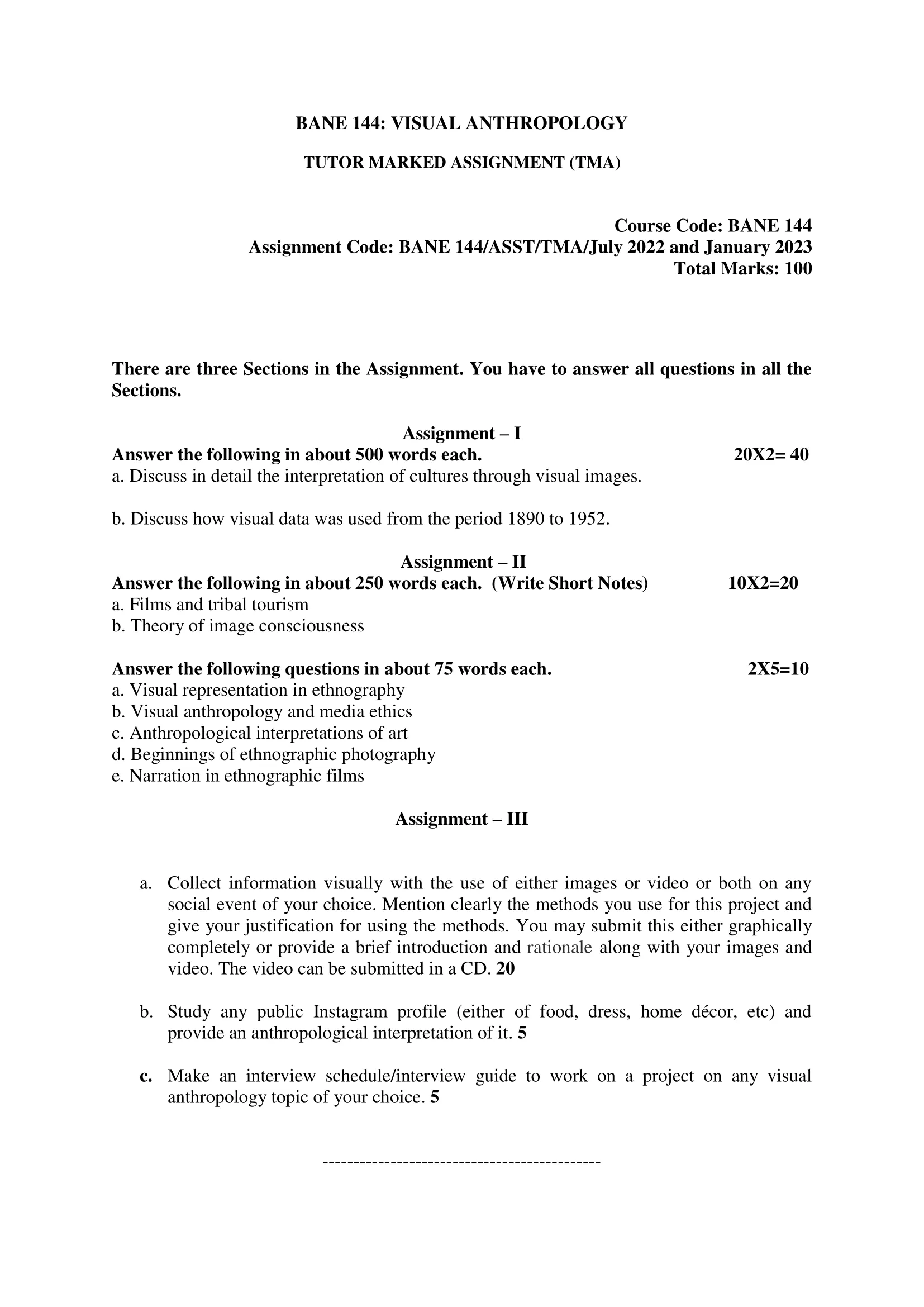Contents
- 1 Assignment – I
- 2 Answer the following in about 500 words each. 20X2= 40
- 3 a. Discuss in detail the interpretation of cultures through visual images.
- 4 b. Discuss how visual data was used from the period 1890 to 1952.
- 5 Assignment – II
- 6 Answer the following in about 250 words each. (Write Short Notes) 10X2=20
- 7 a. Films and tribal tourism
- 8 b. Theory of image consciousness
- 9 Answer the following questions in about 75 words each. 2X5=10
- 10 a. Visual representation in ethnography
- 11 b. Visual anthropology and media ethics
- 12 c. Anthropological interpretations of art
- 13 d. Beginnings of ethnographic photography
- 14 e. Narration in ethnographic films
- 15 Assignment – III

| Title | BANE-144: IGNOU BAG Solved Assignment 2022-2023 |
| University | IGNOU |
| Degree | Bachelor Degree Programme |
| Course Code | BANE-144 |
| Course Name | VISUAL ANTHROPOLOGY |
| Programme Name | Bachelor of Arts (General) |
| Programme Code | BAG |
| Total Marks | 100 |
| Year | 2022-2023 |
| Language | English |
| Assignment Code | BANE 144/ASST/TMA/July 2022 and January 2023 |
| Last Date for Submission of Assignment: | For June Examination: 31st April For December Examination: 30th September |

Assignment – I
Answer the following in about 500 words each. 20X2= 40
a. Discuss in detail the interpretation of cultures through visual images.
Ans: Culture is a complex phenomenon that encompasses a wide range of values, beliefs, customs, behaviors, and symbols that are shared by a particular group of people. Visual images, such as paintings, photographs, sculptures, and illustrations, play a significant role in shaping our understanding of cultural identity, history, and traditions. These images serve as visual representations of cultural values, beliefs, and customs, and they provide us with a unique way of interpreting and appreciating the richness and diversity of different cultures.
The interpretation of cultures through visual images is a multi-layered process that involves considering various aspects such as the historical context, the cultural context, the style and technique of the image, and the intended message or purpose of the image. For example, a painting from the Renaissance era may depict religious themes and reflect the dominant values and beliefs of the time, while a contemporary photograph may capture the changing attitudes and norms of modern society.
One of the most important ways in which visual images interpret cultures is through the representation of cultural symbols and iconography. Cultural symbols, such as flags, coat of arms, and monuments, serve as visual representations of a particular culture’s values, beliefs, and identity. Iconography, or the use of symbols and images in art, helps to convey the cultural values and beliefs of a particular society. For example, in ancient Egyptian art, the depiction of the pharaohs as all-powerful and divine beings reflects the cultural values of the time, where the pharaoh was considered to be a god on earth.
Another way in which visual images interpret cultures is through the representation of cultural traditions and customs. For example, a painting of a traditional wedding ceremony in a particular culture may depict the various rituals and customs associated with the event, such as the dress, the music, and the food. This type of visual representation helps us to understand the cultural traditions and customs of a particular society, and it provides us with a deeper appreciation for the diversity of cultural practices around the world.
In addition to representing cultural symbols and traditions, visual images can also be used to interpret cultures through the representation of social and political issues. For example, political cartoons and illustrations often use humor and satire to comment on current events and political issues, and they can provide us with a deeper understanding of the cultural attitudes and beliefs of a particular society. Similarly, photographs and paintings can be used to document social and political events, such as wars, protests, and revolutions, and they provide us with a visual record of these important moments in history.
Finally, visual images can also be used to interpret cultures through the representation of individual experiences and perspectives. For example, photographs and paintings can be used to depict personal experiences, such as childhood memories, family life, and individual identity. These visual representations help us to understand the complexities of individual experiences and perspectives, and they provide us with a unique window into the cultural and social norms of a particular society.
b. Discuss how visual data was used from the period 1890 to 1952.
Ans: The period from 1890 to 1952 marked a time of rapid technological and societal change, and visual data played an important role in shaping our understanding of this era. During this time, visual data was used in a variety of ways, including scientific research, social and political activism, advertising, and popular entertainment.
One of the most important ways in which visual data was used during this period was in scientific research. Visual data was often used to gather information about various aspects of the natural world, such as plant and animal life, geology, and the behavior of natural phenomena such as storms and earthquakes. For example, the invention of motion picture cameras in the late 19th century allowed scientists to capture and study the behavior of animals in their natural habitats. Additionally, early forms of data visualization, such as maps and graphs, were used to represent and analyze scientific data.
Another way in which visual data was used during this period was in social and political activism. Visual data was used to document the living and working conditions of marginalized groups, such as workers, women, and people of color, and to raise awareness about issues such as poverty, inequality, and discrimination. For example, photographers and journalists used photographs and illustrations to document the conditions of factory workers, migrant laborers, and other working-class people. Similarly, suffragettes used posters and illustrations to advocate for women’s right to vote and to raise awareness about the suffrage movement.
Visual data was also used extensively in advertising during this period. Advertisers used photographs, illustrations, and other forms of visual data to sell products and services, and to shape cultural attitudes and beliefs about consumer goods and lifestyle. For example, magazines and advertisements from the period often featured images of women and men in idealized, stylized poses, promoting fashion and beauty products, home goods, and other consumer items.
Finally, visual data was also used extensively in popular entertainment during this period. Motion pictures, for example, became a popular form of entertainment, and filmmakers used visual data to create captivating stories and characters. Visual data was also used in various forms of popular media, such as comic books, advertisements, and theater productions, to entertain and engage audiences.
Assignment – II
Answer the following in about 250 words each. (Write Short Notes) 10X2=20
a. Films and tribal tourism
Ans: Films and tribal tourism have a unique relationship that has evolved over the years. The depiction of tribal communities and their culture in films has often been instrumental in promoting tribal tourism. The visual representation of the lives of tribals, their customs, traditions, and beliefs, have piqued the interest of people, leading to an increase in the number of tourists visiting tribal regions.
However, the impact of films on tribal tourism is not always positive. Often, filmmakers tend to portray the tribals in a stereotypical manner, presenting a distorted image of their culture, which can have negative consequences on tribal tourism. This type of representation can create unrealistic expectations among tourists and also impact the tribals in several ways, including the loss of their privacy, cultural degradation, and exploitation.
To mitigate the negative impact of films on tribal tourism, it is crucial for filmmakers to be culturally sensitive and to accurately depict the life and culture of the tribals. The films should showcase the tribals’ traditions, beliefs, and customs in an authentic and respectful manner, without presenting them as exotic or primitive. This will not only help to promote tribal tourism but also help in preserving the rich cultural heritage of the tribals.
b. Theory of image consciousness
Ans: The theory of image consciousness refers to the concept that people’s perceptions of themselves and others are shaped by images they encounter in various forms of media. This includes images in advertising, films, television, social media, and other visual media. These images often represent idealized versions of reality and create unrealistic expectations of beauty, success, and personal relationships.
The theory of image consciousness argues that people are heavily influenced by these images, leading to a distorted sense of self and others. They develop a need to conform to these idealized images and engage in practices such as cosmetic surgery, body modification, and other forms of self-enhancement to achieve this ideal. This can lead to a negative impact on their mental health and self-esteem, as they struggle to live up to the unrealistic expectations set by these images.
Moreover, image consciousness also impacts the way people perceive others. People are more likely to judge others based on their physical appearance, rather than their character or personality, leading to discrimination and prejudice.
To mitigate the negative impact of image consciousness, it is crucial to raise awareness about the impact of media images on self-perception and perception of others. People should be encouraged to challenge the images they encounter in media and to question the unrealistic expectations they create. Additionally, media literacy programs should be developed to educate people on the ways in which media images are constructed and how to critically analyze them.
Answer the following questions in about 75 words each. 2X5=10
a. Visual representation in ethnography
Ans: Visual representation plays a significant role in ethnography, which is the study of human cultures and societies. Ethnographers often use visual techniques such as photography, film, and illustration to capture the essence of a culture and to represent the perspectives and experiences of the people they are studying. The visual representation in ethnography is intended to be an accurate and respectful representation of the culture and to provide insights into the beliefs, customs, and traditions of the community. However, visual representation in ethnography must also be mindful of the potential impact on the community and should be made with cultural sensitivity and accuracy. By using visual representation, ethnographers can offer a unique window into the world of different cultures, allowing people to gain a deeper understanding of the complexities and richness of human societies.
b. Visual anthropology and media ethics
Ans: Visual anthropology is the study of human culture and behavior through the use of visual media such as photography, film, and video. As a field that involves the representation of people and their cultures, visual anthropology is subject to certain ethical considerations. In particular, media ethics plays a crucial role in the production of visual media in anthropology. This includes ensuring that the representation of cultures is culturally sensitive and respectful, avoiding the exploitation of individuals or communities, and obtaining informed consent from participants. Additionally, visual anthropologists must also consider the potential impact of their work on the communities they are studying and the audience that will view the work. The adherence to media ethics is essential to ensure that visual anthropology remains a valuable tool for understanding and documenting human cultures in an ethical and responsible manner.
c. Anthropological interpretations of art
Ans: Anthropological interpretations of art examine the cultural significance and context of various forms of artistic expression. Anthropologists view art as a form of cultural expression that reveals important information about a society’s beliefs, values, and practices. They study art within the larger context of culture and use it to understand the cultural practices, beliefs, and values of a particular group. Anthropologists also consider the role that art plays in shaping cultural identity and the way in which it is used to communicate ideas and experiences. By examining the relationships between art and culture, anthropologists gain a deeper understanding of the cultural practices and beliefs of a particular group. Their interpretations of art can provide unique insights into the social and cultural structures of a society and contribute to a deeper understanding of human cultures and societies.
d. Beginnings of ethnographic photography
Ans: The beginnings of ethnographic photography can be traced back to the mid-19th century with the advent of portable cameras and new photographic technologies. Early ethnographic photographers utilized photography as a tool for documenting and studying non-Western cultures, often as part of colonial projects. Their photographs aimed to capture the physical appearance, cultural practices, and daily life of the communities they were studying. While these early ethnographic photographs often perpetuated stereotypes and perpetuated colonial power dynamics, they also served as an important historical record of the cultures and peoples that were being documented. The use of photography in ethnography has since evolved, with photographers and anthropologists striving to create culturally sensitive and respectful representations of the communities they study. Nevertheless, the beginnings of ethnographic photography marked the beginning of a new era in the documentation and understanding of human cultures and societies.
e. Narration in ethnographic films
Ans: Narration in ethnographic films plays a crucial role in shaping the viewer’s understanding of the culture and community being represented. Ethnographic filmmakers use narration to provide context, insight, and interpretation of the events and cultural practices being documented on film. Narration can be used to highlight important cultural practices and beliefs, to provide historical context, and to explain the significance of what is being portrayed on screen. The use of narration can also play a role in shaping the viewer’s perspective and understanding of the culture being represented. Ethnographic filmmakers must be mindful of the potential impact of their narration on the communities they are studying and must strive to maintain cultural sensitivity and accuracy in their representation. The effective use of narration can enhance the impact of ethnographic films and contribute to a deeper understanding of human cultures and societies.
Assignment – III
a. Collect information visually with the use of either images or video or both on any social event of your choice. Mention clearly the methods you use for this project and give your justification for using the methods. You may submit this either graphically completely or provide a brief introduction and rationale along with your images and video. The video can be submitted in a CD. 20
Ans: One method you can use to visually collect information is through photography. You can take photographs of various aspects of the social event, such as the setting, the people, the activities, and the atmosphere. By taking photographs, you can capture the details and atmosphere of the event in a way that would be difficult to convey through words alone.
Another method you can use is video recording. Video allows you to capture not only the visual elements of the event but also the sounds and movements of the event. This can provide a more complete and immersive experience for the viewer.
When collecting images or videos for a social event, it is important to obtain informed consent from the people involved. This includes obtaining consent for the use of their images or videos for the purpose of your project. It is also important to maintain cultural sensitivity and respect for the people and community involved in the event.
The use of both images and video can provide a comprehensive and diverse representation of the social event. By using a combination of visual media, you can capture the various aspects and perspectives of the event, providing a more complete and nuanced representation.
b. Study any public Instagram profile (either of food, dress, home décor, etc) and provide an anthropological interpretation of it. 5
Ans:
Anthropological interpretation of a public Instagram profile involves analyzing the visual and cultural representations presented in the profile. This can include examining the way in which the objects, food, dress, home décor, etc. are presented and the cultural meanings and values they represent. Additionally, you can analyze the interactions between the user and their followers, including the comments and likes, to understand the ways in which the profile is perceived and received by others.
By analyzing the visual representations in the profile, you can gain a deeper understanding of the cultural values, beliefs, and practices of the user and their community. This can provide insight into the ways in which people use Instagram as a platform for self-expression and cultural representation.
It is important to consider the potential biases and limitations of using social media as a source of cultural information. Additionally, it is crucial to approach the interpretation of social media profiles with cultural sensitivity and respect for the individuals and communities represented.
c. Make an interview schedule/interview guide to work on a project on any visual anthropology topic of your choice.
Ans: Here is an example of an interview schedule/interview guide for a project on the topic of visual representation in ethnographic film:
- Introduction (5 minutes)
- Introduce yourself and the purpose of the interview
- Explain the project and the importance of the participant’s perspective
- Obtain informed consent from the participant
- Background information (10 minutes)
- Ask the participant about their background and experience with ethnographic film
- Ask about their education, work experience, and any relevant cultural background
- Ask about their personal connection to the topic of visual representation in ethnographic film
- Perceptions of visual representation in ethnographic film (20 minutes)
- Ask the participant about their perceptions of visual representation in ethnographic film
- Ask about the role they believe visual representation plays in ethnographic film
- Ask about their thoughts on the impact of visual representation on cultural representation and understanding
- Ask about the challenges and limitations they see in using visual representation in ethnographic film
- Personal experiences with visual representation in ethnographic film (15 minutes)
- Ask the participant about their personal experiences with ethnographic film
- Ask about specific examples of ethnographic films they have seen or participated in
- Ask about their experiences with the visual representation in these films
- Ask about any insights they gained from these experiences
- Final thoughts (5 minutes)
- Ask the participant if there is anything else they would like to share about the topic
- Thank the participant for their time and contribution to the project
- Close the interview by reiterating the purpose and importance of the project
It is important to note that this is just one example of an interview guide and that the specific questions and topics may need to be adapted based on the specific project and research goals. Additionally, it is important to maintain cultural sensitivity and respect for the participants and their perspectives throughout the interview process.
How to Download BANE-144 Solved Assignment?
You can download it from the www.edukar.in, they have a big database for all the IGNOU solved assignments.
Is the BANE-144 Solved Assignment Free?
Yes this is absolutely free to download the solved assignment from www.edukar.in
What is the last submission date for BANE-144 Assignment?
For June Examination: 31st April, For December Examination: 30th October
















